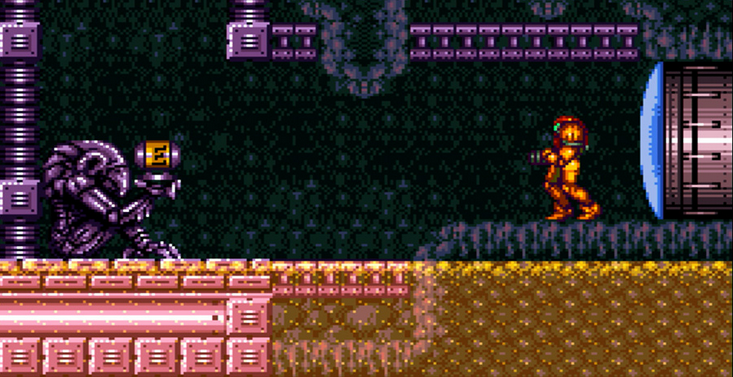One of the more complex games for Super Nintendo is Super Metroid. With interweaving pathways and a lack of spoon-fed objectives, this game can beguile even the most astute players.
Given my lack of a Super Nintendo during the 16-bit era, I decided to finally play through Super Metroid for the first time. However, I imposed one simple challenge:
No strategy guides.
Would Super Metroid’s game design help to light my path to success? The hypothesis is that if I persisted, I’d inevitably beat this notorious game. Also… think of the bragging rights!
Here’s how that went.

No Sleep ‘Til Zebes
Planet Zebes is the setting for Super Metroid. The first area of this exotic location features a small passageway that could seemingly be navigated by crawling. Unfortunately, Samus (our hero) can’t seem to duck low enough to squeeze through. I’m left to wander nearby caverns in hopes of finding an alternate path.
Before very long, I stumble upon the Morph Ball – a device which allows Samus to transform into a small, rolling ball. On cue, I proceed through the previously-too-small crevice, and continue on my way. This type of encounter is baked into the core of Super Metroid. Obstacles present themselves, and their solutions are simply waiting to be found.

Understanding how Super Metroid handles progression is integral to playing it without a guide. By forcing me to exhaust all my options, the game lead me to the Morph Ball. The result was a sense of accomplishment, as well as moving the experience forward. Of course, this is merely one of Super Metroid’s tricks.
Many of the walls on Zebes are destructible. They also happen to be visually identical to regular walls. Firing upon these walls with Samus’ weapons reveals their secrets. With that, these false barriers mostly conceal optional (and very helpful) power-ups. More notably, this ruse is employed to hide new areas.
After what feels like an eternity of searching for the adventure’s next step, discovering these pathways feel wonderful. Although, how can shooting at the walls be considered a challenge? This brings us to Super Metroid’s map.
Backtracking with purpose
The tiles on Super Metroid’s map use color coding: pink represents explored areas, and purple indicates the unexplored ones. Additionally, a tile may or may not have a border. Where a border is absent, the map continues on in that direction. This is the only indication the player is given to know if they should be hunting for a hidden passage.
Furthermore, the map labels save points, recharge stations, map rooms, and rooms that contain an upgrade for Samus’ armor. While there are many other important landmarks on Zebes, the map takes no responsibility for them.

And so, Super Metroid is testing the player’s ingenuity, as well as their memory. With this, it became clear that I had to start taking mental notes.
“Samus can open green doors now… didn’t I pass a green door earlier?”
Super Metroid, super gratifying
Ultimately, Super Metroid has a way of forcing the player to feel lost. At the same time, a stepping stone to the next area is usually closer than it might seem. However, the emotional payoff for each discovery is worth every second of the struggle.

Personally, I enjoyed the growing pains which Super Metroid put me through. While I didn’t get a 100% completion rating; I learned a lot about myself as a player. Finally, I experienced just how clever the most popular Metroid game can be.
Did you know that Samus Aran is a silent protagonist? If you feel compelled to see what I think of that, check out this article: The Strong, Silent Narrative Type
